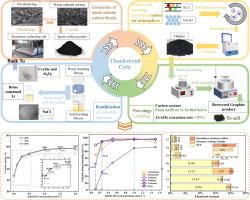低温熔盐焙烧-两段浸出法回收废阴极炭块的高效工艺
IF 9
1区 工程技术
Q1 ENGINEERING, CHEMICAL
引用次数: 0
摘要
废阴极炭(SCC)是铝电解工业产生的有害固体废弃物,含有大量有价值的成分,对生态环境造成严重威胁。熔盐焙烧是一种比湿法冶金直接浸出更有效的SCC分离纯化方法。然而,目前的熔融盐焙烧处理SCC是在惰性气氛和高温条件下进行的,生产成本高,产品经济性低。在此基础上,提出了一种550 °C的低温熔盐焙烧工艺,在空气中添加NaOH,然后依次进行水浸和酸浸,以深度净化SCC。单因素优化实验结果表明,水浸去除了大部分杂质(如Na3AlF6),酸浸进一步转化了难处理物质(如硅铝酸盐),回收石墨的纯度(RG)从43.55 wt%显著提高到98.67 wt%。DFT计算证实了RG在费米能级附近具有较高的态密度(DOS)和较低的Li离子迁移能垒,为RG在锂电池负极材料中的高价值利用提供了理论基础。根据Al和F配合物的溶液平衡化学计算,在最佳条件下,一次浸出液和二次浸出液以冰晶石的形式从溶液中回收96.55%的氟。整个工艺成本低,环保,基本完成了SCC的无害化处理和有价组分的回收。本文章由计算机程序翻译,如有差异,请以英文原文为准。

An efficient recycling process of spent cathode carbon blocks via low temperature molten salt roasting and two stage leaching
Spent cathode carbon (SCC) as a hazardous solid waste from the aluminum electrolysis industry, contains numerous valuable components, but poses a serious threat to ecological environment. Molten salt roasting is an efficient separation and purification method for SCC than directly leaching of hyfrometallurgy. However, the current treatment of SCC by molten salt roasting is under inert atmosphere and high temperature conditions, which causes high production costs and low product economics. Herein, a low-temperature molten salt roasting process with 550 °C and NaOH additive under air atmosphere-followed by water leaching and acid leaching in turn is proposed to deeply purify SCC. A single-factor optimal experiment indicates that most of the impurities, such as Na3AlF6, were removed after water leaching and the refractory substances like silica-aluminate, were further transformed by acid leaching, which results in a significant improvement in the purity of the recovered graphite (RG) from 43.55 wt% to 98.67 wt%. DFT calculations confirm that RG have a greater density of states (DOS) near the Fermi energy level and lower migration energy barriers for Li ion, which provides a theoretical foundation for the high-value utilization of RG in anode material for lithium batteries. The primary and second leach filtrates were combined to recover 96.55% fluorine from solution in the form of cryolite under optimum conditions, based on solution equilibrium chemistry calculations of Al and F complexes. The whole process features low cost and environmental protection, and basically completes harmless treatment of SCC and recovery of valuable components.
求助全文
通过发布文献求助,成功后即可免费获取论文全文。
去求助
来源期刊

Separation and Purification Technology
工程技术-工程:化工
CiteScore
14.00
自引率
12.80%
发文量
2347
审稿时长
43 days
期刊介绍:
Separation and Purification Technology is a premier journal committed to sharing innovative methods for separation and purification in chemical and environmental engineering, encompassing both homogeneous solutions and heterogeneous mixtures. Our scope includes the separation and/or purification of liquids, vapors, and gases, as well as carbon capture and separation techniques. However, it's important to note that methods solely intended for analytical purposes are not within the scope of the journal. Additionally, disciplines such as soil science, polymer science, and metallurgy fall outside the purview of Separation and Purification Technology. Join us in advancing the field of separation and purification methods for sustainable solutions in chemical and environmental engineering.
 求助内容:
求助内容: 应助结果提醒方式:
应助结果提醒方式:


